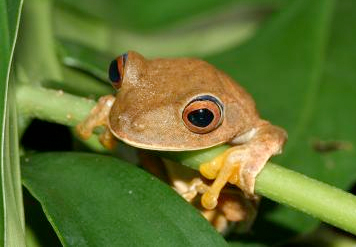|
|
Tree frogs may help scientists inexpensively predict biodiversity hotspots for conservation, report researchers writing in the journal Science.
The method is based on using historical climate records and the mitochondrial DNA sequences of tree frogs to map the species’ past distributions. This can be used to indicate “which regions have been climatically stable, and thus likely to harbor a diversity of species, and which areas have been unstable and likely to be less biodiverse,” according to a statement from UC Bekerley.
“With this method, we can identify areas that have been working as refugia for biodiversity,” said lead author Ana Carolina Carnaval, a post-doc at UC Bekerley. “These are areas that have remained climatically stable through time, where local communities have been able to persist. Despite the fact that we haven’t sampled them exhaustively yet, we think there is a lot of undocumented, hidden diversity there, the potential for a lot of species still unknown to science, and, especially, a lot of endemism.”
 This is the tree frog Hypsiboas semilineatus, common throughout the Atlantic rainforest of Brazil. Credit: Ana Carnaval/UC Berkeley This is the tree frog Hypsiboas semilineatus, common throughout the Atlantic rainforest of Brazil. Credit: Ana Carnaval/UC Berkeley
|
Carnaval and colleagues applied their methodology to the Mata Atlantica forest in Western Brazil. They found that the central region of the forest — the least studied and most threatened part of the Mata Atlantica — has been the most stable, and therefore most biodiverse, section of the Atlantic rainforest.
“The study demonstrates that the southern portion of the Atlantic forest was more climatically unstable during the Late Pleistocene, relative to the central corridor, which served as a large climatic refuge for neotropical species,” explained Carnaval. “Yet, the central region is poorly known and under extreme anthropogenic pressure. This unveils new priorities for conservation that must reach policymakers, the public and NGOs.”
“The study has shown us that the central Atlantic forest, which hasn’t had the investment of resources and effort as the southern, has been stable from a climatic standpoint and therefore is likely more diverse than currently believed. But because this area is under great human impact, it deserves conservation and research priority,” added co-author Craig Moritz, professor of integrative biology and director of UC Berkeley’s Museum of Vertebrate Zoology.
The researchers plan to apply to technique in other parts of the world.
“The broader story is that we think this technique could be applied in other countries and other hotspot areas to identify regions that haven’t been well sampled yet, regions that could possibly harbor as yet undiscovered unique diversity,” Carnaval said. “This is a general method for identifying and prioritizing hotspots within hotspots, for finding highly diverse areas that have not been fully explored.”
“Ana and her colleagues have discovered, using a very simple approach of combining genetics and environmental modeling, how we can make pretty strong predictions that can guide conservation efforts,” Moritz concluded.
CITATION: Ana Carnaval et al. Stability Predicts Genetic Diversity in the Brazilian Atlantic Forest Hotspot. Science February 6, 2009